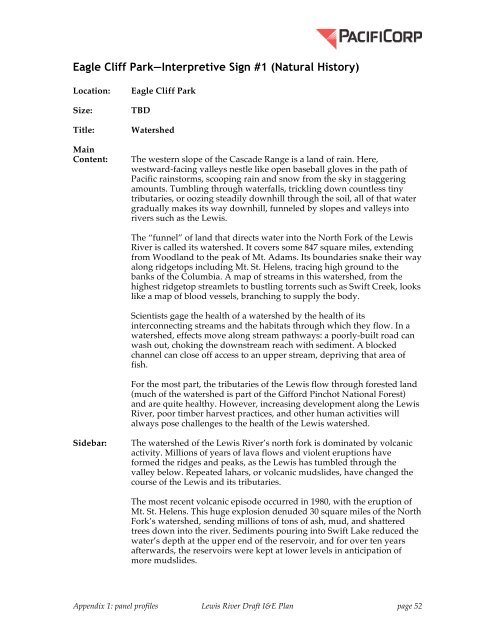The Lewis River Hydroelectric Projects - PacifiCorp
The Lewis River Hydroelectric Projects - PacifiCorp
The Lewis River Hydroelectric Projects - PacifiCorp
Create successful ePaper yourself
Turn your PDF publications into a flip-book with our unique Google optimized e-Paper software.
Eagle Cliff Park—Interpretive Sign #1 (Natural History)<br />
Location:<br />
Size:<br />
Title:<br />
Main<br />
Content:<br />
Eagle Cliff Park<br />
TBD<br />
Watershed<br />
<strong>The</strong> western slope of the Cascade Range is a land of rain. Here,<br />
westward-facing valleys nestle like open baseball gloves in the path of<br />
Pacific rainstorms, scooping rain and snow from the sky in staggering<br />
amounts. Tumbling through waterfalls, trickling down countless tiny<br />
tributaries, or oozing steadily downhill through the soil, all of that water<br />
gradually makes its way downhill, funneled by slopes and valleys into<br />
rivers such as the <strong>Lewis</strong>.<br />
<strong>The</strong> “funnel” of land that directs water into the North Fork of the <strong>Lewis</strong><br />
<strong>River</strong> is called its watershed. It covers some 847 square miles, extending<br />
from Woodland to the peak of Mt. Adams. Its boundaries snake their way<br />
along ridgetops including Mt. St. Helens, tracing high ground to the<br />
banks of the Columbia. A map of streams in this watershed, from the<br />
highest ridgetop streamlets to bustling torrents such as Swift Creek, looks<br />
like a map of blood vessels, branching to supply the body.<br />
Scientists gage the health of a watershed by the health of its<br />
interconnecting streams and the habitats through which they flow. In a<br />
watershed, effects move along stream pathways: a poorly-built road can<br />
wash out, choking the downstream reach with sediment. A blocked<br />
channel can close off access to an upper stream, depriving that area of<br />
fish.<br />
For the most part, the tributaries of the <strong>Lewis</strong> flow through forested land<br />
(much of the watershed is part of the Gifford Pinchot National Forest)<br />
and are quite healthy. However, increasing development along the <strong>Lewis</strong><br />
<strong>River</strong>, poor timber harvest practices, and other human activities will<br />
always pose challenges to the health of the <strong>Lewis</strong> watershed.<br />
Sidebar:<br />
<strong>The</strong> watershed of the <strong>Lewis</strong> <strong>River</strong>’s north fork is dominated by volcanic<br />
activity. Millions of years of lava flows and violent eruptions have<br />
formed the ridges and peaks, as the <strong>Lewis</strong> has tumbled through the<br />
valley below. Repeated lahars, or volcanic mudslides, have changed the<br />
course of the <strong>Lewis</strong> and its tributaries.<br />
<strong>The</strong> most recent volcanic episode occurred in 1980, with the eruption of<br />
Mt. St. Helens. This huge explosion denuded 30 square miles of the North<br />
Fork’s watershed, sending millions of tons of ash, mud, and shattered<br />
trees down into the river. Sediments pouring into Swift Lake reduced the<br />
water’s depth at the upper end of the reservoir, and for over ten years<br />
afterwards, the reservoirs were kept at lower levels in anticipation of<br />
more mudslides.<br />
Appendix 1: panel profiles <strong>Lewis</strong> <strong>River</strong> Draft I&E Plan page 52
















